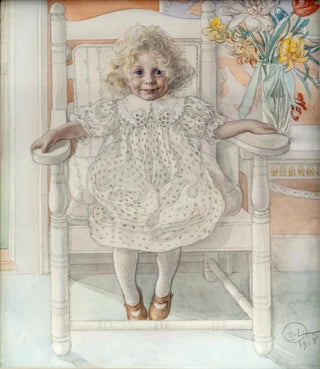Art print | Portrait of Inga Maria Thiel - Carl Larsson


View from behind

Frame (optional)
Art print Portrait of Inga Maria Thiel - Carl Larsson – Captivating Introduction
The "Portrait of Inga Maria Thiel" by Carl Larsson is much more than a simple pictorial representation. It is an open window into the intimacy of a bygone era, a reflection of human relationships and emotions that transcend time. In this work, Larsson captures not only the physical beauty of his model but also a spiritual essence, a depth of soul that invites the viewer to ponder the inner life of the young woman. This portrait, imbued with delicacy, evokes a warm, almost familiar atmosphere that echoes the love the artist bore for his muse and life partner. The soft light bathing Inga's face, along with the meticulous details of her costume, testify to Larsson's skill in marrying technique and emotion.
Style and uniqueness of the work
Carl Larsson's style is characterized by an intimate and sensitive approach, where each stroke is carefully thought out to evoke a particular ambiance. In the "Portrait of Inga Maria Thiel," the artist uses a palette of soft colors, blending pastel tones with more vivid shades, thus creating a captivating visual harmony. The flowing lines and delicate shapes draw a face filled with serenity and grace. Larsson has the gift of bringing out the personality of his models, and here, Inga seems to live through the canvas, her eyes sparkling with life and intelligence. This portrait also stands out through its context, rooted in Scandinavian tradition, while incorporating elements of the Arts & Crafts movement, which advocates the importance of craftsmanship and beauty in everyday life. This fusion of styles and influences makes the work unique, both rooted in its era and timeless.
The artist and his influence
Carl Larsson, an emblematic figure of Swedish art, established himself as a master of portraiture and genre painting. Born in 1853, he evolved within a vibrant artistic milieu, influenced by naturalism and symbolism. His work, often focused on domestic life and family scenes, reflects

Matte finish

View from behind

Frame (optional)
Art print Portrait of Inga Maria Thiel - Carl Larsson – Captivating Introduction
The "Portrait of Inga Maria Thiel" by Carl Larsson is much more than a simple pictorial representation. It is an open window into the intimacy of a bygone era, a reflection of human relationships and emotions that transcend time. In this work, Larsson captures not only the physical beauty of his model but also a spiritual essence, a depth of soul that invites the viewer to ponder the inner life of the young woman. This portrait, imbued with delicacy, evokes a warm, almost familiar atmosphere that echoes the love the artist bore for his muse and life partner. The soft light bathing Inga's face, along with the meticulous details of her costume, testify to Larsson's skill in marrying technique and emotion.
Style and uniqueness of the work
Carl Larsson's style is characterized by an intimate and sensitive approach, where each stroke is carefully thought out to evoke a particular ambiance. In the "Portrait of Inga Maria Thiel," the artist uses a palette of soft colors, blending pastel tones with more vivid shades, thus creating a captivating visual harmony. The flowing lines and delicate shapes draw a face filled with serenity and grace. Larsson has the gift of bringing out the personality of his models, and here, Inga seems to live through the canvas, her eyes sparkling with life and intelligence. This portrait also stands out through its context, rooted in Scandinavian tradition, while incorporating elements of the Arts & Crafts movement, which advocates the importance of craftsmanship and beauty in everyday life. This fusion of styles and influences makes the work unique, both rooted in its era and timeless.
The artist and his influence
Carl Larsson, an emblematic figure of Swedish art, established himself as a master of portraiture and genre painting. Born in 1853, he evolved within a vibrant artistic milieu, influenced by naturalism and symbolism. His work, often focused on domestic life and family scenes, reflects






